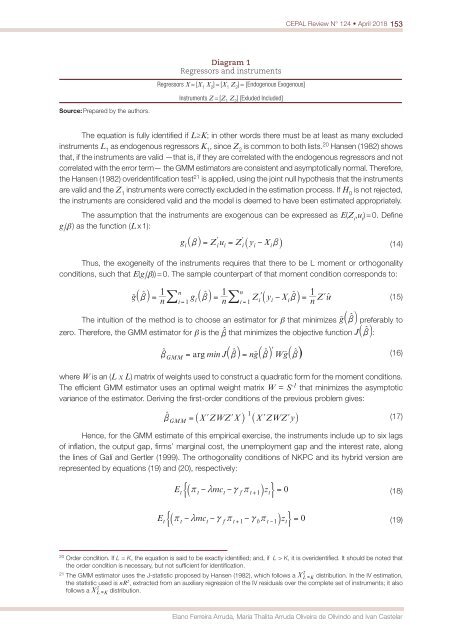CEPAL Review no. 124
April 2018
April 2018
Create successful ePaper yourself
Turn your PDF publications into a flip-book with our unique Google optimized e-Paper software.
<strong>CEPAL</strong> <strong>Review</strong> N° <strong>124</strong> • April 2018 153<br />
Diagram 1<br />
Regressors and instruments<br />
Regressors X = [X 1<br />
X 2<br />
] = [X 1<br />
Z 2<br />
] = [Endoge<strong>no</strong>us Exoge<strong>no</strong>us]<br />
Instruments Z = [Z 1<br />
Z 2<br />
] [Exluded Included]<br />
Source: Prepared by the authors.<br />
The equation is fully identified if L≥K; in other words there must be at least as many excluded<br />
instruments L 1<br />
as endoge<strong>no</strong>us regressors K 1<br />
, since Z 2<br />
is common to both lists. 20 Hansen (1982) shows<br />
that, if the instruments are valid —that is, if they are correlated with the endoge<strong>no</strong>us regressors and <strong>no</strong>t<br />
correlated with the error term— the GMM estimators are consistent and asymptotically <strong>no</strong>rmal. Therefore,<br />
the Hansen (1982) overidentification test 21 is applied, using the joint null hypothesis that the instruments<br />
are valid and the Z 1<br />
instruments were correctly excluded in the estimation process. If H 0<br />
is <strong>no</strong>t rejected,<br />
the instruments are considered valid and the model is deemed to have been estimated appropriately.<br />
The assumption that the instruments are exoge<strong>no</strong>us can be expressed as E(Z i<br />
,u i<br />
) = 0. Define<br />
g i<br />
(β ) as the function (L x 1):<br />
Thus, the exogeneity of the instruments requires that there to be L moment or orthogonality<br />
conditions, such that E(g i<br />
(β)) = 0. The sample counterpart of that moment condition corresponds to:<br />
(14)<br />
(15)<br />
The intuition of the method is to choose an estimator for b that minimizes preferably to<br />
zero. Therefore, the GMM estimator for b is the that minimizes the objective function :<br />
(16)<br />
where W is an (L x L) matrix of weights used to construct a quadratic form for the moment conditions.<br />
The efficient GMM estimator uses an optimal weight matrix W = S -1 that minimizes the asymptotic<br />
variance of the estimator. Deriving the first-order conditions of the previous problem gives:<br />
Hence, for the GMM estimate of this empirical exercise, the instruments include up to six lags<br />
of inflation, the output gap, firms’ marginal cost, the unemployment gap and the interest rate, along<br />
the lines of Galí and Gertler (1999). The orthogonality conditions of NKPC and its hybrid version are<br />
represented by equations (19) and (20), respectively:<br />
(17)<br />
(18)<br />
(19)<br />
20<br />
Order condition. If L = K, the equation is said to be exactly identified; and, if L > K, it is overidentified. It should be <strong>no</strong>ted that<br />
the order condition is necessary, but <strong>no</strong>t sufficient for identification.<br />
21<br />
The GMM estimator uses the J-statistic proposed by Hansen (1982), which follows a distribution. In the IV estimation,<br />
the statistic used is nR 2 , extracted from an auxiliary regression of the IV residuals over the complete set of instruments; it also<br />
follows a distribution.<br />
Ela<strong>no</strong> Ferreira Arruda, Maria Thalita Arruda Oliveira de Olivindo and Ivan Castelar


















